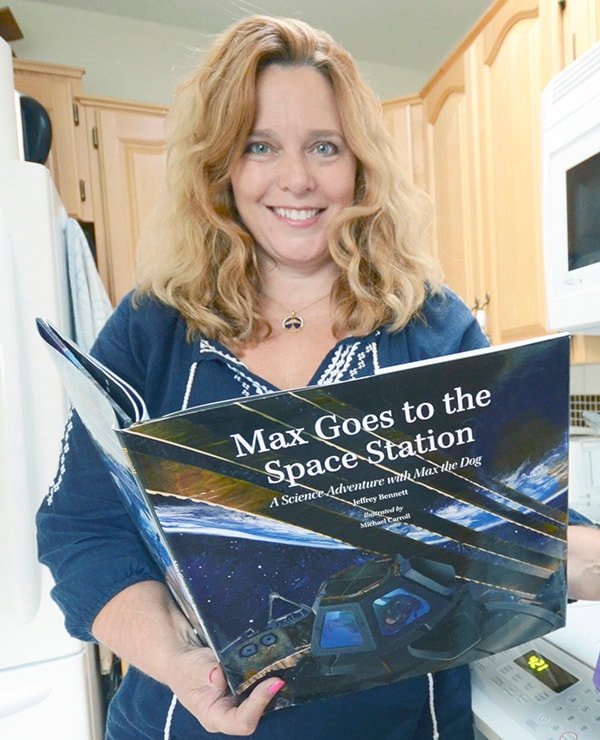There was a huge sigh of relief locally with the successful rendezvous of the SpaceX Dragon cargo ship and International Space Station (ISS) this week.
It came from Penticton educator Patricia Tribe.
 Among the more than two tons of supplies being delivered by the unmanned spacecraft was a small package of Canadian content very dear to her heart.
Among the more than two tons of supplies being delivered by the unmanned spacecraft was a small package of Canadian content very dear to her heart.
Inside it were the nine replacement science experiments for those destroyed in the catastrophic loss of the original payload in June 2015 when the SpaceX CRS-7 rocket exploded just after take off from Cape Canaveral, Fla. (Read more here: Nasa rocket explodes)
That equipment, valued at $70,000, is designed to complement author Jeffrey Bennett’s science content for the Story Time From Space program developed by Tribe.
Readings and the experiments done by the ISS astronauts are being integrated into a curriculum and will be available to the educators and children on earth when the program is complete.
Tribe and veteran Canadian astronaut Bjarni Tryggvason designed the experiments and watched Monday’s early-morning launch together on Skype.
“The launch was intense and absolutely spectacular and once it got going, man it was beautiful,” said Tribe, the CEO of the non-profit Global Space Education Foundation which has partnered on the project with NASA and the Centre for the Advancement of Science in Space. “I didn’t hold my breath, I was really listening intently to what they were saying and watching the rocket.”
She added having seen about 10 launches in person has changed how she now views the lift offs.
“It’s very different watching it when you know the people on it or know the equipment on it,” she said. “You kind of have a vested interest, a sense of ownership.”
Tribe, the former Director of Education at the Space Centre Houston, began working on the concept about six years ago. (Read more on this here: Penticton woman's space program)
Its initial beginnings were during the 2011 STS 133 mission which was the final flight of the Discovery shuttle.
Astronauts, including Tribe’s friend Alvin Drew, downloaded some of the material, video taped the readings and after the project literally took off.
Things were going along smoothly up until the 2015 disaster, which Tribe was worried could spell the end of the project.
“We were stunned when we lost our first science payload; that was a bad day, to say the least,” she said. “But our supporters saw the value in what we were trying to accomplish and dug deep to send us back up. We could not have rebuilt this amazing hardware without everyone’s support.”
 For his part, Tryggvason, who joked he was initially “cornered” into working on the space-reading project, took this week’s launch in stride.
For his part, Tryggvason, who joked he was initially “cornered” into working on the space-reading project, took this week’s launch in stride.
“I’m not surprised, I knew this day would come, I’ve been in the space game a long time, it’s just the nature of the beast it’s just very challenging,” said Tryggvason, 71, in a telephone interview from his home in London, Ont.
A payload specialist about the 1997 Discovery mission, Tryggvason believes the education system has taken a “nose dive” when it comes to math and science and this program is a way to reverse that.
“It’s going to produce real science for kids to see, explore, and compare to what happens on Earth, and it’s also sophisticated enough for high school and college students to use in higher level research projects,” he said. “The equipment we have built with our partners explores basic science concepts in the free-fall environment. There is a huge misconception of the way things work in space that there is something magic up there there’s a great deal of confusion and this will change that.”
The experiments explore the concepts of light, surface tension, pendulums, heat transfer, free fall, orbits, balance and buoyancy.
“All of which are basic science concepts educators teach children,” said Tribe. “Do they all work the same in the free fall environment of the space station compared to on earth? We will find out.”
Both she and Tryggvason credited the efforts of the University of Toronto, P&P Opitca, Bennett’s publisher Big Kid Science for assistance once again to make the project a reality. Tribe also thanked the many local people who donated to the GoFundMe campaign set up last year. With the experiments now in place, Tribe hopes the program will soon be completed and ready for use.
“Without much publicity we’ve had over 100,000 people on the website from all over the world, it’s pretty phenomenal,” she said. “I’m not surprised because everybody has loved the idea and the concept of having the astronauts reading with the kids and doing the science with the kids.”
She is planning a sneak preview of the program on Sept. 27 at the Okanagan Falls Regional Library, which will include an on-screen astronaut reading and live experiment.
For more on the program visit www.storytimefromspace.com.
